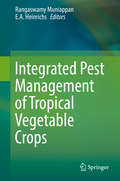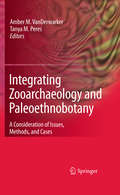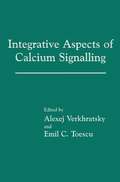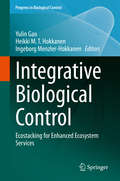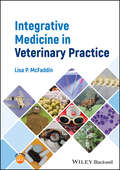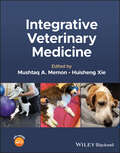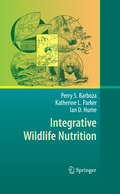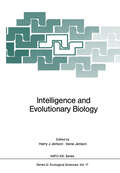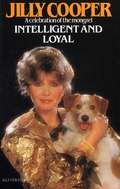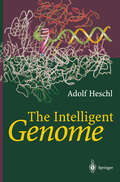- Table View
- List View
Integrated Pest Control in Citrus Groves
by R. CavalloroThis book is an outcome of the proceedings of the expert's meeting on the protection of citrus groves held in Acireale in 1985. It focuses on the methods and strategies of integrated control taking into account the influence of some phytochemicals on the physiology of the citrus crop.
Integrated Pest Management: Volume 2: Dissemination and Impact
by Rajinder Peshin Ashok K. DhawanIntegrated Pest Management – Dissemination and Impact, Volume 2 is a sequel to Integrated Pest Management – Innovation-DevelopmentProcess, Volume 1. The book focuses on the IPM systems in the developed countries of North America, Europe and Australia, and the developing countries of Asia, Latin America and Africa. One of the major impedimentsin the dissemination and adoption of the IPM innovation is the complexity of the technology and reaching the vast population of farmers especially in the developing countries. The IPM-innovation development process is incomplete without the diffusion and adoption of IPM methods by the end users, and through its consequences. In spite of all the efforts in the developed and developing countries, the adoption of IPM is still low with few exceptions. The book covers the underlying concepts and methodologies of the diffusion of innovation theory and the program evaluation; and reviews the progress and impact of IPM programs implemented in the industrialized, the green revolution and the subsistence agricultural systems of the world. Forty-four experts from entomology, plant pathology, environmental science, agronomy, anthropology, economics and extensioneducationfromAfrica, Asia, Australia, Europe,NorthAmerica and South America have discussed impact of IPM with an interdisciplinary perspective. Each one of the experts is an authority in his or her eld of expertise. The researchers, farmers’education,supportingpoliciesofthegovernmentsandmarketforcesarethe elements of the IPM innovation system to achieve wider adoption of IPM strategy in agriculture.
Integrated Pest Management: Volume 1: Innovation-Development Process
by Rajinder Peshin Ashok K. DhawanThe book ‘Silent Spring’ written by Rachel Carson in 1962, is considered the la- mark in changing the attitude of the scientists and the general public regarding the complete reliance on the synthetic pesticides for controlling the ravages caused by the pests in agriculture crops. For about ve decades, the Integrated Pest Mana- ment (IPM) is the accepted strategy for managing crop pests. IPM was practiced in Canet ˜ e Valley, Peru in 1950s, even before the term IPM was coined. Integrated Pest management: Innovation-Development Process, Volume 1, focuses on the recog- tion of the dysfunctional consequences of the pesticide use in agriculture, through researchanddevelopmentoftheIntegratedPest Managementinnovations. Thebook aims to update the information on the global scenario of IPM with respect to the use of pesticides, its dysfunctional consequences, and the concepts and advan- ments made in IPM systems. This book is intended as a text as well as reference material for use in teaching the advancements made in IPM. The book provides an interdisciplinary perspective of IPM by the forty-three experts from the eld of entomology, plant pathology, plant breeding, plant physiology, biochemistry, and extension education. The introductory chapter (Chapter 1) gives an overview of IPM initiatives in the developed and developing countries from Asia, Africa, Australia, Europe, Latin America and North America. IPM concepts, opportunities and challenges are d- cussed in Chapter 2.
Integrated Pest Management: Experiences with Implementation, Global Overview, Vol.4
by Rajinder Peshin David PimentelThe book deals with the present state and problems of integrated pest management (IPM) as relating to stakeholder acceptance of IPM and how IPM can become a sustainable practice. The book covers the implementation of integrated pest management in USA, Canada, Denmark, Germany, Italy, Sweden, Netherlands, China, India, Indonesia, Australia, Africa, and its impact in reducing pesticide use in agriculture. The book also deals with the impact of transgenic crops on pesticide use.
Integrated Pest Management: Pesticide Problems, Vol.3
by David Pimentel Rajinder PeshinThe book deals with the present state and problems of integrated pest management as relating to stakeholder acceptance of IPM and how integrated pest management can become a sustainable practice. The discussions include using less pesticides and the possibility of eliminating pesticides from agricultural practice.
Integrated Pest Management for Collections: Proceedings of 2011: A Pest Odyssey, 10 Years Later (English Heritage)
by Peter Winsor, David Pinniger, Louise Bacon, Bob Child, Kerren Harris, Dee Lauder, Julie Phippard and Amber Xavier-RoweIntegrated pest management (IPM) is not a static approach but one that is constantly evolving. Mass international travel, climate change and other factors contribute to the spread of new pests, and the pests themselves are constantly seeking out weaknesses in our defences. An understanding of the threats pests pose to collections and the necessity for a systematic approach to combat them is now firmly embedded in the work of collection care practitioners. In addition, the trustees and sponsoring bodies of collecting institutions recognise that it is a significant and cost-effective element of good collections management. 2011: A Pest Odyssey, 10 years later describes examples of how the IPM approach has been adopted by large and small institutions around the world, and highlights the many lessons learned along the way. Principal among these is never to become complacent and tied down to routine processes. Another important lesson is the need to ensure colleagues understand and are involved with the process of pest management. There is also a need to understand the wider implications of any pest control activity, for example the effect of chemical treatments on DNA. Coming out of the second Pest Odyssey conference, this book will promote wider understanding and implementation of IPM as an integral part of any collection management programme. The organisers and editorial team hope that everyone involved with the care of cultural heritage collections and buildings will find something of interest and value in this work.
Integrated Pest Management of Tropical Vegetable Crops
by Rangaswamy Muniappan E. A. HeinrichsIt is an edited book with chapters written by multi-disciplinary specialists in their specific subject areas. It covers development of IPM components and packaging them for individual vegetable crops specifically targeted to tropical countries. Scientific background for IPM components or tactics will be included. There will be case studies of IPM packages developed and implemented in different countries. The concept of IPM has been in existence for the past six decades; however, a practical holistic program has not been developed and implemented for vegetable crops, in the developing countries. Currently the IPM adoption rate in the tropics is minimal and there is a need for implementation of IPM technologies that are environmentally safe, economical, and socially acceptable. We believe that adoption and implementation of IPM provided in this book will lead to significant reduction in crop losses and mitigate adverse impacts of pesticide use in the tropics. This book is an outcome 20 years of research, development and implementation of the IPM CRSP, a project supported by USAID and administered by Virginia Tech in several developing countries along the tropical belt in Africa, Asia, Latin America and the Caribbean.
Integrated Tse-tse Fly Control
by R. CavalloroThis book discusses methods which might appropriately be employed under various circumstances. It is concerned with control of insect pests and tse-tse flies, and considers prospects for integrated control of the African trypanosomiases, in which vector control is envisaged as playing a key role.
Integrated Tse-tse Fly Control: Proceedings Of The Cec International Symposium/ispra 4-6 March 1986
by R. CavalloroThis book discusses methods which might appropriately be employed under various circumstances. It is concerned with control of insect pests and tse-tse flies, and considers prospects for integrated control of the African trypanosomiases, in which vector control is envisaged as playing a key role.
Integrating Complementary Medicine into Veterinary Practice
by Paula Jo Broadfoot Richard E. Palmquist Karen Johnston Jiu Jia Wen Barbara FougereIntegrating complementary treatment options with traditional veterinary practice is a growing trend in veterinary medicine. Veterinarians and clients alike have an interest in expanding treatment options to include alternative approaches such as Western and Chinese Herbal Medicine, Acupuncture, Nano-Pharmacology, Homotoxicology, and Therapeutic Nutrition along with conventional medicine. Integrating Complementary Medicine into Veterinary Practice introduces and familiarizes veterinarians with the terminology and procedures of these complementary treatment modalities in a traditional clinical format that facilitates the easy integration of these methods into established veterinary practices.
Integrating Zooarchaeology and Paleoethnobotany: A Consideration of Issues, Methods, and Cases
by Amber M. VanDerwarker Tanya M. PeresIn recent years, scholars have emphasized the need for more holistic subsistence analyses, and collaborative publications towards this endeavor have become more numerous in the literature. However, there are relatively few attempts to qualitatively integrate zooarchaeological (animal) and paleoethnobotanical (plant) data, and even fewer attempts to quantitatively integrate these two types of subsistence evidence. Given the vastly different methods used in recovering and quantifying these data, not to mention their different preservational histories, it is no wonder that so few have undertaken this problem. Integrating Zooarchaeology and Paleoethnobotany takes the lead in tackling this important issue by addressing the methodological limitations of data integration, proposing new methods and innovative ways of using established methods, and highlighting case studies that successfully employ these methods to shed new light on ancient foodways. The volume challenges the perception that plant and animal foodways are distinct and contends that the separation of the analysis of archaeological plant and animal remains sets up a false dichotomy between these portions of the diet. In advocating qualitative and quantitative data integration, the volume establishes a clear set of methods for (1) determining the suitability of data integration in any particular case, and (2) carrying out an integrated qualitative or quantitative approach.
Integration in Respiratory Control: From Genes to Systems (Advances in Experimental Medicine and Biology #605)
by Richard J. A. Wilson Marc PoulinThis volume comprises the proceedings of the 10th Oxford Conference held at Lake Louise, Alberta, Canada, in September, 2006. It contains the most up-to-date research in cardio-respiratory control and its content spans the disciplines of respiratory physiology, neurobiology, modeling, and biomedical engineering. The volume will be of interest to clinicians working with patients with breathing disorders.
Integration of Insect-Resistant Genetically Modified Crops within IPM Programs (Progress in Biological Control #5)
by Jörg Romeis George Kennedy Anthony M. SheltonInsect pests remain one of the main constraints to food and fiber production worldwide despite farmers deploying a range of techniques to protect their crops. Modern pest control is guided by the principles of integrated pest management (IPM) with pest resistant germplasm being an important part of the foundation. Since 1996, when the first genetically modified (GM) insect-resistant maize variety was commercialized in the USA, the area planted to insect-resistant GM varieties has grown dramatically, representing the fastest adoption rate of any agricultural technology in human history. The goal of our book is to provide an overview on the role insect-resistant GM plants play in different crop systems worldwide. We hope that the book will contribute to a more rational debate about the role GM crops can play in IPM for food and fiber production.
Integration of Pharmaceutical Discovery and Development: Case Histories (Pharmaceutical Biotechnology #11)
by Ronald T. Borchardt Roger M. Freidinger Tomi K. Sawyer Philip L. SmithIn the late 1980s, it became painfully evident to the pharmaceutical industry that the old paradigm of drug discovery, which involved highly segmented drug - sign and development activities, would not produce an acceptable success rate in the future. Therefore, in the early 1990s a paradigm shift occurred in which drug design and development activities became more highly integrated. This new str- egy required medicinal chemists to design drug candidates with structural f- tures that optimized pharmacological (e. g. , high affinity and specificity for the target receptor), pharmaceutical (e. g. , solubility and chemical stability), bioph- maceutical (e. g. , cell membrane permeability), and metabolic/pharmacokinetic (e. g. , metabolic stability, clearance, and protein binding) properties. Successful implementation of this strategy requires a multidisciplinary team effort, incl- ing scientists from drug design (e. g. , medicinal chemists, cell biologists, en- mologists, pharmacologists) and drug development (e. g. , analytical chemists, pharmaceutical scientists, physiologists, and molecular biologists representing the disciplines of pharmaceutics, biopharmaceutics, and pharmacokinetics/drug metabolism). With this new, highly integrated approach to drug design now widely utilized by the pharmaceutical industry, the editors of this book have provided the sci- tific community with case histories to illustrate the nature of the interdisciplinary interactions necessary to successfully implement this new approach to drug d- covery. In the first chapter, Ralph Hirschmann provides a historical perspective of why this paradigm shift in drug discovery has occurred.
Integrative Aspects of Calcium Signalling
by Alexej Verkhratsky Emil C. ToescuHere is the first effort in a single volume to cover all of the integrative functions of calcium signalling - how changes in intracellular calcium coordinate a variety of coherent cellular responses. Written by a team of internationally established researchers, Integrative Aspects of Calcium Signalling provides the latest experimental data and concepts, bringing together a detailed analysis of the events, processes, and functions regulated by calcium signalling. A unique resource for professionals and students of physiology, biophysics, neurobiology, biochemistry, and all related fields.
Integrative Biological Control: Ecostacking for Enhanced Ecosystem Services (Progress in Biological Control #20)
by Yulin Gao Heikki M. T. Hokkanen Ingeborg Menzler-HokkanenThis book is the first to integrate biological control into a conceptual framework – ecostacking - uniting all aspects of biological control and ecosystem services. In 2018 the "First International Congress of Biological Control" was organised and held in Beijing, China. The chapters highlight some of the achievements presented at the congress, worldwide. Of particular significance are the numerous contributions by Chinese researchers illustrating the remarkable progress made on developing and adopting multiple biological control strategies over vast agricultural areas, largely replacing chemical pesticides for sustainable agricultural and horticultural production. In many parts of the world including Europe, fragmented research based on short-term funding has been unable to answer to the needs to develop sustainable long-term solutions to crop protection, while colleagues in China have been successful in implementing programs that exemplify the power of the ecostacking approach. Key contributions by European and US specialists combined with the expertise and experiences by the Chinese contributors comprise the building blocks for the integration of biological control approaches into the overall frame of ecostacking. This book will lead the way to a broader, integrated adoption of biological control techniques in sustainable pest, disease and weed management supporting also the functioning of other key ecosystem services.Chapter 2 of this book isavailable openaccess under a CC BY 4.0 license at link.springer.com
Integrative Functions in the Mammalian Auditory Pathway (Springer Handbook of Auditory Research #15)
by Donata OertelA summary of how the electrical signals used to represent sounds are encoded and interpreted through the integrated roles of various nuclei. This volume builds on the information about the anatomy and physiology of the auditory pathway found in volumes 1 and 2 of the SHAR series. While the first two volumes describe the structure and function of auditory pathways, this one explains how these pathways lead to an animal's ability to localize and interpret sounds.
Integrative Medicine in Veterinary Practice
by Lisa P. McFaddinIntegrative Medicine in Veterinary Practice Enables the entire veterinary team to seamlessly incorporate integrative medicine into everyday practice Integrative Medicine in Veterinary Practice is a unique resource designed to introduce the basic concepts of ten different integrative modalities to all members of the hospital team to establish a baseline of knowledge: explaining how patients will benefit from their use, discussing return on investment, informing veterinarians of available courses and suggested reading materials, walking managers through staff training, and providing client education materials. Supplemental web-based documents and presentations increase the ease with which staff are trained and clients are educated. Integrative medicine is not an all-or-nothing concept. This umbrella term encompasses a wide spectrum of treatment modalities. Therapies can be used individually or in combination, as part of a multimodal approach, and applied easily to every patient or used in select cases. Sample topics covered in Integrative Medicine in Veterinary Practice include: Photobiomodulation, covering light, laser specifics, mechanisms of action, supplies and equipment, and techniques Veterinary Spinal Manipulation Therapy (VSMT), covering pain in veterinary patients, mechanisms of action, adjustment vs. manipulation vs. mobilization, techniques, and post-adjustment recommendations Acupuncture, covering acupuncture point selection using traditional Chinese veterinary medicine (TCVM) and Western medicine techniques, mechanisms of action, safety, and practical applications. Chinese Herbal Medicine (CHM), covering TCVM fundamentals as it applies to herbal classification and selection, herb production, safety, and formulation, and CHM applications. Integrative Medicine in Veterinary Practice is a valuable resource for all veterinary hospital team members, from customer service representatives to veterinary assistants/technicians, practice managers, and veterinarians. The text is also helpful to veterinary students interested in integrative medicine, or those taking introductory integrative medicine courses.
Integrative Medicine in Veterinary Practice
by Lisa P. McFaddinIntegrative Medicine in Veterinary Practice Enables the entire veterinary team to seamlessly incorporate integrative medicine into everyday practice Integrative Medicine in Veterinary Practice is a unique resource designed to introduce the basic concepts of ten different integrative modalities to all members of the hospital team to establish a baseline of knowledge: explaining how patients will benefit from their use, discussing return on investment, informing veterinarians of available courses and suggested reading materials, walking managers through staff training, and providing client education materials. Supplemental web-based documents and presentations increase the ease with which staff are trained and clients are educated. Integrative medicine is not an all-or-nothing concept. This umbrella term encompasses a wide spectrum of treatment modalities. Therapies can be used individually or in combination, as part of a multimodal approach, and applied easily to every patient or used in select cases. Sample topics covered in Integrative Medicine in Veterinary Practice include: Photobiomodulation, covering light, laser specifics, mechanisms of action, supplies and equipment, and techniques Veterinary Spinal Manipulation Therapy (VSMT), covering pain in veterinary patients, mechanisms of action, adjustment vs. manipulation vs. mobilization, techniques, and post-adjustment recommendations Acupuncture, covering acupuncture point selection using traditional Chinese veterinary medicine (TCVM) and Western medicine techniques, mechanisms of action, safety, and practical applications. Chinese Herbal Medicine (CHM), covering TCVM fundamentals as it applies to herbal classification and selection, herb production, safety, and formulation, and CHM applications. Integrative Medicine in Veterinary Practice is a valuable resource for all veterinary hospital team members, from customer service representatives to veterinary assistants/technicians, practice managers, and veterinarians. The text is also helpful to veterinary students interested in integrative medicine, or those taking introductory integrative medicine courses.
Integrative Veterinary Medicine
by Mushtaq A. Memon Huisheng XieIntegrative Veterinary Medicine Practical guide integrating holistic modalities into Western veterinary practice to help with patient treatment Integrative Veterinary Medicine provides a clinically oriented, evidence-based guide to integrating complementary and conventional therapies into veterinary practice. Covering acupuncture, manual therapies, botanical and herbal medicine, integrative nutrition, and physical rehabilitation, the book draws information on these modalities together into a single resource. Rooted in evidence-based medicine, it demonstrates how to use these modalities in veterinary practice. The book begins by discussing the basic concepts of integrative veterinary medicine, then examines each modality in detail. A companion website offers video clips showing acupuncture techniques. In Integrative Veterinary Medicine, readers can expect to find detailed information on topics such as: Anatomy and physiology of acupuncture with relation to soft tissue and neurologic concepts, and traditional Chinese theory of acupuncture (Yin and Yang, Five Element Theory, and The Meridians) Veterinary manipulative therapy (neurology, biomechanics, and available evidence), and massage therapy and myofascial principles Origins and major systems of herbal therapy with selected evidence-based interventions and adverse events, herb-drug interactions, supplement evaluation, and regulation Trends in nutrition, such as raw diets, home-prepared diets, grain-free diets, owner perception, and current marketing Covering common modalities across all species in one volume, Integrative Veterinary Medicine is an essential reference for any veterinary practitioner wishing to use integrative techniques in their practices, as well as veterinary students, academics, and researchers involved in programs of study related to integrative veterinary medicine.
Integrative Veterinary Medicine
by Mushtaq A. Memon Huisheng XieIntegrative Veterinary Medicine Practical guide integrating holistic modalities into Western veterinary practice to help with patient treatment Integrative Veterinary Medicine provides a clinically oriented, evidence-based guide to integrating complementary and conventional therapies into veterinary practice. Covering acupuncture, manual therapies, botanical and herbal medicine, integrative nutrition, and physical rehabilitation, the book draws information on these modalities together into a single resource. Rooted in evidence-based medicine, it demonstrates how to use these modalities in veterinary practice. The book begins by discussing the basic concepts of integrative veterinary medicine, then examines each modality in detail. A companion website offers video clips showing acupuncture techniques. In Integrative Veterinary Medicine, readers can expect to find detailed information on topics such as: Anatomy and physiology of acupuncture with relation to soft tissue and neurologic concepts, and traditional Chinese theory of acupuncture (Yin and Yang, Five Element Theory, and The Meridians) Veterinary manipulative therapy (neurology, biomechanics, and available evidence), and massage therapy and myofascial principles Origins and major systems of herbal therapy with selected evidence-based interventions and adverse events, herb-drug interactions, supplement evaluation, and regulation Trends in nutrition, such as raw diets, home-prepared diets, grain-free diets, owner perception, and current marketing Covering common modalities across all species in one volume, Integrative Veterinary Medicine is an essential reference for any veterinary practitioner wishing to use integrative techniques in their practices, as well as veterinary students, academics, and researchers involved in programs of study related to integrative veterinary medicine.
Integrative Wildlife Nutrition
by Perry S. Barboza Katherine L. Parker Ian D. HumeNutrition spans a wide range of mechanisms from acquisition of food to digestion, absorption and retention of energy substrates, water and other nutrients. Nutritional principles have been applied to improving individual health, athletic performance and longevity of humans and of their companion animals, and to maximizing agricultural efficiency by manipulating reproduction or growth of tissues such as muscle, hair or milk in livestock. Comparative nutrition borrows from these tra- tional approaches by applying similar techniques to studies of ecology and physiology of wildlife. Comparative approaches to nutrition integrate several levels of organization because the acquisition and flow of energy and nutrients connect individuals to populations, populations to communities, and communities to ecosystems. Integrative Wildlife Nutrition connects behavioral, morphological and biochemical traits of animals to the life history of species and thus the dynamics of populations. An integrated approach to nutrition provides a practical framework for understanding the interactions between food resources and wildlife popu- tions and for managing the harvest of abundant species and the conservation of threatened populations. This book is for students and professionals in animal physiology and ecology, conservation biology and wildlife management. It is based on our lectures, dem- strations and practical classes taught in the USA, Canada and Australia over the last three decades. Instructors can use Integrative Wildlife Nutrition as a text in wildlife and conservation biology programs, and as a reference source for related courses in wildlife ecology.
Intelligence and Evolutionary Biology (Nato ASI Subseries G: #17)
by Harry J. Jerison Irene JerisonIn evolutionary biology, "intelligence" must be defined in terms of traits that are subject to the major forces of organic evolution. Accordingly, this volume is concerned with the substantive questions that are relevant to the evolutionary problem. Comparisons of learning abilities are highlighted by a detailed report on similarities between honeybees and higher vertebrates. Several chapters are concerned with the evolution of cerebral lateralization and the control of language, and recent analyses of the evolution of encephalization and neocorticalization, including a review of effects of domestication on brain size are presented. The relationship between brain size and intelligence is debated vigorously. Most unusual, however, is the persistent concern with analytic and philosophical issues that arise in the study of this topic, from the applications of new developments on artificial intelligence as a source of cognitive theory, to the recognition of the evolutionary process itself as a theory of knowledge in "evolutionary epistemology".
Intelligent and Loyal
by Jilly Cooper ObeA celebration of the mongrel.The mongrel occupies a special place in our hearts and homes. Jilly Cooper collected stories from hundreds of owners to write this engaging and affectionate tribute. She presents a delightful account of the lives and natures of a vast assortment of dogs of doubtful parentage: a fascinating, moving and entertaining chronicle of their exploits and accomplishments, their bravery, devotion and wisdom. Jilly's special method of classification enables you to tell instantly if your pet is a Woolly Whitejaw, a Borderline Collie, a Bertrand Russell or a Lancashire Hot Pet. At last, our mongrels have achieved the recognition they have so long deserved...
The Intelligent Genome: On the Origin of the Human Mind by Mutation and Selection
by Adolf HeschlDo our genes determine our behavior? Do humans occupy a unique position in evolution? To clarify these provoking questions, the author takes the reader on an ambitious and entertaining journey through a variety of scientific disciplines. In doing so, he creates an image of human evolution that argues that our entire individual knowledge is determined - to the smallest detail - by phylogeny. A provoking and controversial analysis of the theory of our inability to learn something new and of the extent to which our behavior is determined by our genes.






